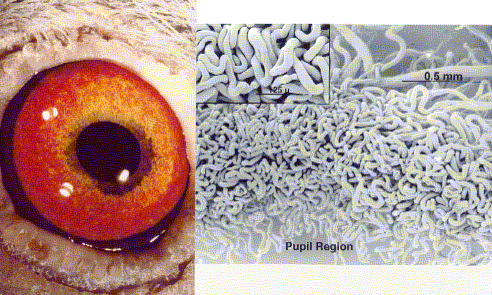Interesting information about Racing Pigeon RespirationBy: John VanceI have been reading summaries of interesting work done a few years ago on pigeons and thought I would further summarize those works for the subscribers of this newsletter. First of all, for you eye sign enthusiast one study points out that birds (and most animals) control a percentage of their heat transfer through their eyes. Think of the eye in this instance as a radiator like what you would find in your automobile. As water flows through the radiator, cooling is accomplished and engine temperature is controlled. In the same way, blood travelling through the eye is cooled. In the Case of our birds, the venous structure of the eye acts just like the coils in an automobile radiator. The more looped the veins are in the eye, the more cooling surface there is for heat exchange. Beyond all the rings that are expressed as important in an eye from the standpoint of eye sign enthusiasts, possibly as important is the heat exchange capacity of the eye. I should also point out that this same structure of veins that allows for heat exchange also allows for an exchange of O2 and CO2 between air and blood which increases the brain's ability to function properly during very taxing flight conditions. I have included a photo in the article that shows somewhat the structure of veins or (capillaries) that allow for this heat and O2 exchange mechanism. 
The racing pigeon's brain is far away from the major heat pump (mouth, throat, lungs and air sacs). The blood gets hot on its journey from the heart to the brain, because of all the heat generated by the breast muscles. Therefore an ancillary heat exchange process takes place to cool the blood before it enters the brain. This ancillary system makes use several structures of the neck and head in order to accomplish this cooling of the blood prior to entering the brain. The blood is actually cooled in the neck (plexus venosus intracutaneous collaris) and then cooled again by evaporation from the nasal and buccal mucosa and the ocular surfaces. Some other interesting work I read pointed to the overall heat exchange in a pigeon while in flight. While in flight, metabolic rates are nine to ten times higher than when a bird is at rest. consequently, our birds have much higher internal heat loads to dissipate. As mentioned above the eyes are heat exchange units as are the nasal passages and the air sacs. In fact, while our birds are in flight, their respiratory rate is about 20 times as fast as when at rest. The mechanism for cooling is evaporation. One reason birds flying in hot weather with high dew points might have some trouble is that a high dew point, points to higher temperature and higher moisture content in the air and that translates into less efficient heat exchange. If a bird is breathing in hot moist air and is trying to expel hot moist air to cool itself, then there is less heat exchange than when the ambient air is cooler or dryer. However, only about 26% - 33 % of heat exchange is carried out by respiratory heat loss in a flying pigeon, the bulk of evaporative heat loss is by cutaneous heat exchange, that is by surface cooling of the bird. I know many say our birds do not sweat, but they actually do. When they are at rest, they can easily control their body temperature by fluffing or tightening their feathers, which exposes or blankets the skin. Birds at rest, even in postal shipping creates would not appear to sweat, but in flight under stressful conditions, this is exactly what they do as one method of heat exchange. I believe that the leading edge of the wing with its bones and large surface area facilitates heat exchange during flight, and that even the primary and secondary flight feathers might be useful heat sinks as flying exposes the thinly feathered ventral wing and dissipates heat by convection. Something to think about! |